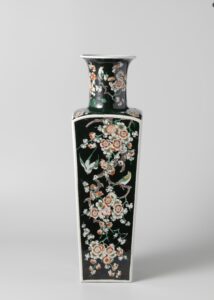Category
Ceramics
Start
2023
Status
Active
Acronym
ENAMEL_ID
Dating Chinese and Japanese porcelain on the basis of stylistic characteristics alone is proving to be more and more problematic. This problem is caused by an appreciation for tradition in styles and the associated long, virtually consistent manufacture of certain types of porcelain in China and Japan, culminating in a visually similar repertoire. In addition to this attribution problem many fakes appear on the market which systematically copy the original pieces. In the Rijksmuseum, the question of dating a number of pieces of porcelain has again become topical. It concerns pieces that have been in the collection for some time (and therefore cannot be a recent forgery). The question is specifically whether they were made in the period c. 1700 (this is how we date them on stylistic grounds), or whether they date from the period c. 1900, a time when there was renewed interest in these types of porcelain. In order to solve this problem an analytical programme is proposed which involves the build-up of comprehensive scientific compositional data-bank through non-destructive, in situ XRF of known, contemporary enamels in order to utilize compositional and technological information as a dating marker for enamels on these types of porcelains.
The study proposed here will concentrate on three specific cases to explore the feasibility and resolution of an approach involving a non-destructive chemical compositional analysis. Because of the importance and high value of the selected collection, the results of this study will resonate in the wider field as a point of reference.
1) Famille noire porcelain, China. ca. 1700; Famille noire has been a subject of study and debate for years (see bibliography). Around 1900, large famille noire vases were among the most expensive works of art on the international art market, but since about 1960 no large piece of famille noire is believed to be old (from about 1700). The Rijksmuseum has two vases (AK-RBK-14283 en 14284) that fit exactly into this discussion. In the US, a major exhibition on Chinese porcelain from around 1700 is in the making and there this discussion has flared up again. It would thus be timely to join this international discussion and explore the dating of the vases thoroughly. As an important comparative, pieces in a similar technique and with an ‘unsuspicious’ provenance (i.e. ‘certainly’ circa 1700) can be found in the Rijksmuseum collection (AK-NM-6588; ex coll J.Th. Royer pre 1814). Furthermore in Dresden and in Beijing are important pieces for (analytical) reference. In the Netherlands, too, attention has been paid to the dating of famille noire with a good number of objects initially tested with XRF so a critical mass of data to solve this problem can be acquired.
2) Famille verte porcelain, China; These materials belong ‘by repute’ to the above mentioned collection of J.Th. Royer. Two pieces belong to this 18th-century collection without any doubt and can serve as reference pieces. However, for the rest the Museum administration is not watertight and pieces may have been added to the Royer collection at a later date. Because we would like to use the Royer collection as a reference collection, therefore it is important to assess which objects originally belong to it and which ones have been added later. Because one of the Vases (AK-NM-6456) is broken the opportunity exists to take samples and to do more (than non-invasive) research, such as SEM-EDS or LA-ICP-MS.
3) Kakiemon porcelain, Japan; The dating of Kakiemon porcelain is also subject to debate given the extensive copying in recent decades which interlinks with the problem of the Chinese porcelains indicated above. The original production of around 1670-1700 cannot in every instance be separated from the pieces that were produced around 1900. The collection of the Rijksmuseum counts several pieces of which the date is beyond doubt, combined with items that may well be of around 1900. Comparison of the composition of enamels would be targeted, together with analysis of the brown iron wash on the rim which holds additional differentiation potential.

Druckervaas, anonymous, ca. 1700